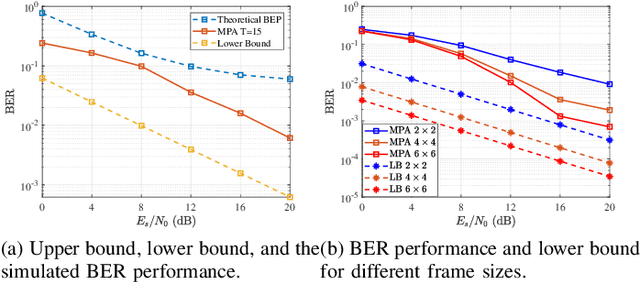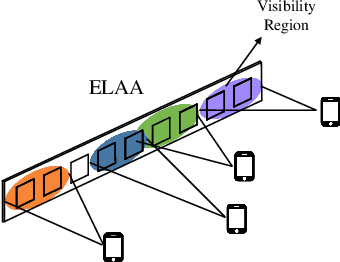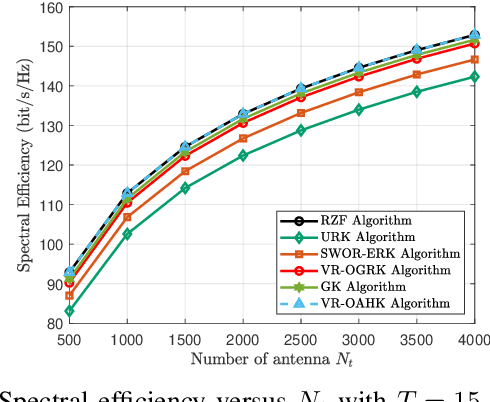Cunhua Pan
Fellow, IEEE
Large-Model AI for Near Field Beam Prediction: A CNN-GPT2 Framework for 6G XL-MIMO
Oct 26, 2025Abstract:The emergence of extremely large-scale antenna arrays (ELAA) in millimeter-wave (mmWave) communications, particularly in high-mobility scenarios, highlights the importance of near-field beam prediction. Unlike the conventional far-field assumption, near-field beam prediction requires codebooks that jointly sample the angular and distance domains, which leads to a dramatic increase in pilot overhead. Moreover, unlike the far- field case where the optimal beam evolution is temporally smooth, the optimal near-field beam index exhibits abrupt and nonlinear dynamics due to its joint dependence on user angle and distance, posing significant challenges for temporal modeling. To address these challenges, we propose a novel Convolutional Neural Network-Generative Pre-trained Transformer 2 (CNN-GPT2) based near-field beam prediction framework. Specifically, an uplink pilot transmission strategy is designed to enable efficient channel probing through widebeam analog precoding and frequency-varying digital precoding. The received pilot signals are preprocessed and passed through a CNN-based feature extractor, followed by a GPT-2 model that captures temporal dependencies across multiple frames and directly predicts the near-field beam index in an end-to-end manner.
Performance Analysis of OAMP Detection for ODDM Modulation in Satellite Communications
Jun 24, 2025

Abstract:Towards future 6G wireless networks, low earth orbit (LEO) satellites have been widely considered as a promising component to enhance the terrestrial communications. To ensure the link reliability of high-mobility satellite communication scenarios, the emerging orthogonal delay-Doppler division multiplexing (ODDM) modulation has attracted significant research attention. In this paper, we study the diversity gain achieved by ODDM modulation along with the mathematical analysis and numerical simulations. Additionally, we propose an orthogonal approximate message passing (OAMP) algorithm based detector to harvest the diversity gain promised by ODDM modulation. By operating the linear and non-linear estimator iteratively, the orthogonal approximate message passing (OAMP) detector can utilize the sparsity of the effective delay-Doppler (DD) domain channel and extract the full diversity. Simulation results reveal the relationship between diversity gain and system parameters, and demonstrate that our proposed detector can achieve better performance than the conventional message passing methods with significantly reduced complexity.
From Large AI Models to Agentic AI: A Tutorial on Future Intelligent Communications
May 28, 2025Abstract:With the advent of 6G communications, intelligent communication systems face multiple challenges, including constrained perception and response capabilities, limited scalability, and low adaptability in dynamic environments. This tutorial provides a systematic introduction to the principles, design, and applications of Large Artificial Intelligence Models (LAMs) and Agentic AI technologies in intelligent communication systems, aiming to offer researchers a comprehensive overview of cutting-edge technologies and practical guidance. First, we outline the background of 6G communications, review the technological evolution from LAMs to Agentic AI, and clarify the tutorial's motivation and main contributions. Subsequently, we present a comprehensive review of the key components required for constructing LAMs. We further categorize LAMs and analyze their applicability, covering Large Language Models (LLMs), Large Vision Models (LVMs), Large Multimodal Models (LMMs), Large Reasoning Models (LRMs), and lightweight LAMs. Next, we propose a LAM-centric design paradigm tailored for communications, encompassing dataset construction and both internal and external learning approaches. Building upon this, we develop an LAM-based Agentic AI system for intelligent communications, clarifying its core components such as planners, knowledge bases, tools, and memory modules, as well as its interaction mechanisms. We also introduce a multi-agent framework with data retrieval, collaborative planning, and reflective evaluation for 6G. Subsequently, we provide a detailed overview of the applications of LAMs and Agentic AI in communication scenarios. Finally, we summarize the research challenges and future directions in current studies, aiming to support the development of efficient, secure, and sustainable next-generation intelligent communication systems.
Performance Analysis of Cooperative Integrated Sensing and Communications for 6G Networks
May 14, 2025Abstract:In this work, we aim to effectively characterize the performance of cooperative integrated sensing and communication (ISAC) networks and to reveal how performance metrics relate to network parameters. To this end, we introduce a generalized stochastic geometry framework to model the cooperative ISAC networks, which approximates the spatial randomness of the network deployment. Based on this framework, we derive analytical expressions for key performance metrics in both communication and sensing domains, with a particular focus on communication coverage probability and radar information rate. The analytical expressions derived explicitly highlight how performance metrics depend on network parameters, thereby offering valuable insights into the deployment and design of cooperative ISAC networks. In the end, we validate the theoretical performance analysis through Monte Carlo simulation results. Our results demonstrate that increasing the number of cooperative base stations (BSs) significantly improves both metrics, while increasing the BS deployment density has a limited impact on communication coverage probability but substantially enhances the radar information rate. Additionally, increasing the number of transmit antennas is effective when the total number of transmit antennas is relatively small. The incremental performance gain reduces with the increase of the number of transmit antennas, suggesting that indiscriminately increasing antennas is not an efficient strategy to improve the performance of the system in cooperative ISAC networks.
Modular XL-Array-Enabled 3-D Localization based on Hybrid Spherical-Planar Wave Model in Terahertz Systems
Apr 18, 2025Abstract:This work considers the three-dimensional (3-D) positioning problem in a Terahertz (THz) system enabled by a modular extra-large (XL) array with sub-connected architecture. Our purpose is to estimate the Cartesian Coordinates of multiple user equipments (UEs) with the received signal of the RF chains while considering the spatial non-stationarity (SNS). We apply the hybrid spherical-planar wave model (HSPWM) as the channel model owing to the structual feature of the modular array, and propose a 3-D localization algorithm with relatively high accuracy and low complexity. Specifically, we first distinguish the visible sub-arrays (SAs) located in the VR and estimate the angles-of-arrival (AoAs) from each UE to typical visible SAs with the largest receive power via compressed sensing (CS) method. In addition, we apply the weighted least square (WLS) method to obtain a coarse 3-D position estimation of each UE according to the AoA estimations. Then, we estimate the AoAs of the other SAs with a reduced dictionary (RD)-CS-based method for lower computational complexity, and utilize all the efficient AoA estimations to derive a fine position estimation. Simulation results indicate that the proposed positioning framework based on modular XL-array can achieve satisfactory accuracy with evident reduction in complexity. Furthermore, the deployment of SAs and the allocation of antenna elements need to be specially designed for better positioning performance.
Secure Directional Modulation with Movable Antenna Array Aided by RIS
Apr 10, 2025



Abstract:In this paper, to fully exploit the performance gains from moveable antennas (MAs) and reconfigurable intelligent surface (RIS), a RIS-aided directional modulation \textcolor{blue}{(DM)} network with movable antenna at base station (BS) is established Based on the principle of DM, a BS equipped with MAs transmits legitimate information to a single-antenna user (Bob) while exploiting artificial noise (AN) to degrade signal reception at the eavesdropper (Eve). The combination of AN and transmission beamforming vectors is modeled as joint beamforming vector (JBV) to achieve optimal power allocation. The objective is to maximize the achievable secrecy rate (SR) by optimizing MAs antenna position, phase shift matrix (PSM) of RIS, and JBV. The limited movable range (MR) and discrete candidate positions of the MAs at the BS are considered, which renders the optimization problem non-convex. To address these challenges, an optimization method under perfect channel state information (CSI) is firstly designed, in which the MAs antenna positions are obtained using compressive sensing (CS) technology, and JBV and PSM are iteratively optimized. Then, the design method and SR performance under imperfect CSI is investigated. The proposed algorithms have fewer iterations and lower complexity. Simulation results demonstrate that MAs outperform fixed-position antennas in SR performance when there is an adequately large MR available.
A Framework for Uplink ISAC Receiver Designs: Performance Analysis and Algorithm Development
Mar 04, 2025



Abstract:Uplink integrated sensing and communication (ISAC) systems have recently emerged as a promising research direction, enabling simultaneous uplink signal detection and target sensing. In this paper, we propose flexible projection (FP)-type receivers that unify the projection-type receivers and the successive interference cancellation (SIC)-type receivers by using a flexible tradeoff factor to adapt to dynamically changing uplink ISAC scenarios. The FP-type receivers address the joint signal detection and target response estimation problem through two coordinated phases: 1) Communication signal detection using a reconstructed signal whose composition is controlled by the tradeoff factor, followed by 2) Target response estimation performed through subtraction of the detected communication signal from the received signal. With adjustable tradeoff factors, the FP-type receivers can balance the enhancement of the signal-to-interference-plus-noise ratio (SINR) with the reduction of correlation in the reconstructed signal for communication signal detection. The pairwise error probabilities (PEPs) are analyzed for both maximum likelihood (ML) and zero-forcing (ZF) detectors, revealing that the optimal tradeoff factor should be determined based on the adopted detection algorithm and the relative power of the sensing and communication (S&C) signal. A homotopy optimization framework is first applied for the FP-type receivers with a fixed trade-off factor. This framework is then extended to develop dynamic FP (DFP)-type receivers, which iteratively adjust the trade-off factor for improved algorithm performance and environmental adaptability. Subsequently, two extensions are explored to further enhance the receivers' performance: parallel DFP (PDFP)-type receivers and a block-structured receiver design. Finally, the effectiveness of the proposed receiver designs is verified via simulations.
Uplink Transmission Design for Fluid Antenna-Enabled Multiuser MIMO Systems with Imperfect CSI
Mar 03, 2025



Abstract:This paper investigates a two-timescale uplink transmission framework for a fluid antenna-enabled multiuser multi-input multi-output system (MIMO-FAS). Antenna positions are optimized based on statistical channel state information (CSI), while beamforming vectors at the base station (BS) adapt to instantaneous CSI. Under a Rician fading channel with imperfect CSI, we establish a linear minimum mean square error (LMMSE)-based channel estimation approach and derive a closed-form expression for the achievable uplink rate using a low-complexity maximal-ratio-combining (MRC) detector. The optimization problem is formulated as a minimum user rate maximization problem by optimizing the fluid antenna positions, subject to the feasible region and the minimum spacing distance constraints. To address this non-convex problem, a genetic algorithm (GA) method is proposed, encoding antenna configurations as population individuals. Additionally, an accelerated gradient ascent algorithm is proposed to enhance computational efficiency. Numerical results validate the mathematical derivations and demonstrate that the proposed two-timescale transmission strategy significantly outperforms traditional FPA systems, with both algorithms achieving enhanced gains.
Channel Estimation for RIS-Aided MU-MIMO mmWave Systems with Practical Hybrid Architecture
Feb 08, 2025



Abstract:This paper proposes a correlation-based three-stage channel estimation strategy with low pilot overhead for reconfigurable intelligent surface (RIS)-aided millimeter wave (mmWave) multi-user (MU) MIMO systems, in which both users and base station (BS) are equipped with a hybrid RF architecture. In Stage I, all users jointly transmit pilots and recover the uncompressed received signals to estimate the angle of arrival (AoA) at the BS using the discrete Fourier transform (DFT). Based on the observation that the overall cascaded MIMO channel can be decomposed into multiple sub-channels, the cascaded channel for a typical user is estimated in Stage II. Specifically, using the invariance of angles and the linear correlation of gains related to different cascaded subchannels, we use compressive sensing (CS), least squares (LS), and a one-dimensional search to estimate the Angles of Departure (AoDs), based on which the overall cascaded channel is obtained. In Stage III, the remaining users independently transmit pilots to estimate their individual cascaded channel with the same approach as in Stage II, which exploits the equivalent common RIS-BS channel obtained in Stage II to reduce the pilot overhead. In addition, the hybrid combining matrix and the RIS phase shift matrix are designed to reduce the noise power, thereby further improving the estimation performance. Simulation results demonstrate that the proposed algorithm can achieve high estimation accuracy especially when the number of antennas at the users is small, and reduce pilot overhead by more than five times compared with the existing benchmark approach.
Low-Complexity Iterative Precoding Design for Near-field Multiuser Systems With Spatial Non-Stationarity
Jan 18, 2025



Abstract:Extremely large antenna arrays (ELAA) are regarded as a promising technology for supporting sixth-generation (6G) networks. However, the large number of antennas significantly increases the computational complexity in precoding design, even for linearly regularized zero-forcing (RZF) precoding. To address this issue, a series of low-complexity iterative precoding are investigated. The main idea of these methods is to avoid matrix inversion of RZF precoding. Specifically, RZF precoding is equivalent to a system of linear equations that can be solved by fast iterative algorithms, such as random Kaczmarz (RK) algorithm. Yet, the performance of RK-based precoding algorithm is limited by the energy distributions of multiple users, which restricts its application in ELAA-assisted systems. To accelerate the RK-based precoding, we introduce the greedy random Kaczmarz (GRK)-based precoding by using the greedy criterion-based selection strategy. To further reduce the complexity of the GRK-based precoding, we propose a visibility region (VR)-based orthogonal GRK (VR-OGRK) precoding that leverages near-field spatial non-stationarity, which is characterized by the concept of VR. Next, by utilizing the information from multiple hyperplanes in each iteration, we extend the GRK-based precoding to the aggregation hyperplane Kaczmarz (AHK)-based pecoding algorithm, which further enhances the convergence rate. Building upon the AHK algorithm, we propose a VR-based orthogonal AHK (VR-OAHK) precoding to further reduce the computational complexity. Furthermore, the proposed iterative precoding algorithms are proven to converge to RZF globally at an exponential rate. Simulation results show that the proposed algorithms achieve faster convergence and lower computational complexity than benchmark algorithms, and yield very similar performance to the RZF precoding.
 Add to Chrome
Add to Chrome Add to Firefox
Add to Firefox Add to Edge
Add to Edge